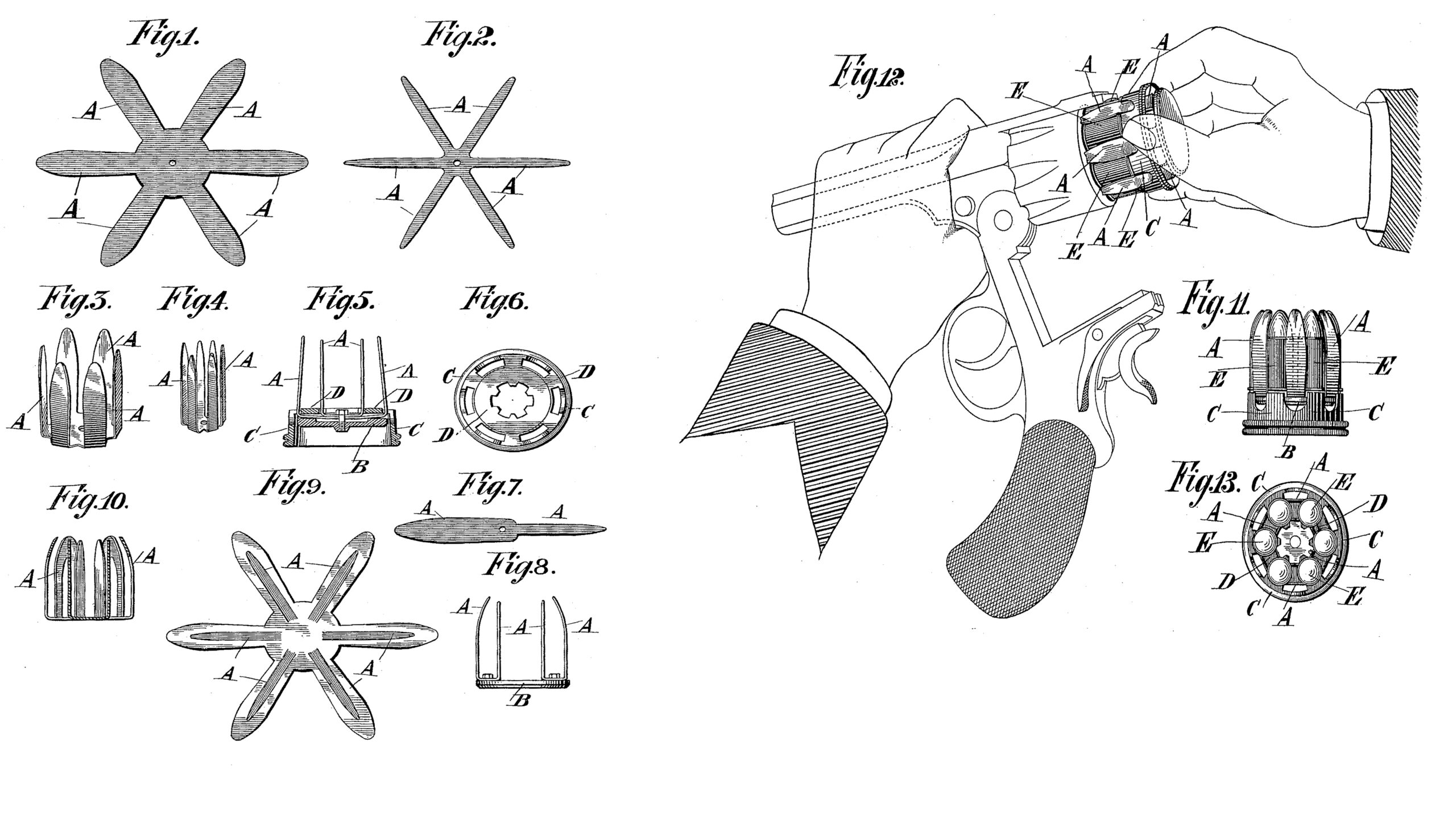US 516942
UNITED STATES PATENT OFFICE.
WILLIAM DE COURCY PRIDEAUX, OF WELLINGTON, ENGLAND.
CARTRIDGE-PACKET HOLDER.
SPECIFICATION forming part of Letters Patent No. 516,942, dated March 20, 1894.
Application filed October 21, 1893. Serial No. 488,806. (No model.) Patented in England February 17, 1893, No. 3,560.
To all whom it may concern:
Be it known that I, WILLIAM DE COURCY PRIDEAUX, a subject of the Queen of Great Britain, and a resident of 5 Fore Street, Wellington, Somerset, England, have invented certain new and useful Improved Means and Apparatus or Magazine for Holding Revolver-Cartridges and for Loading the Same into Revolver-Barrels, (patented in Great Britain No. 3,560, dated February 17, 1893,) of which the following is a specification.
For the purpose of my invention, I make an apparatus, into which a number of cartridges for revolver pistols or rifles can be stored, and from which they can be pushed into the chambers of a revolver at one time for rapidly loading the same.
The invention is intended for use with what are known as breakneck revolvers, and side swing chamber revolvers, such as can, by releasing a strap, fall down on a hinge joint to separate the barrel portion from the “action” portion.
To carry my invention into practice, and such as I show in the annexed drawings, Figure 1 represents a stamped out blank of one set, the larger, of springy metal tongues; Fig. 2, a similar view of a set of smaller tongues, which when bent up, as at Figs. 3 and 4, constitute clips for holding, say, six cartridges between them, at a distance apart corresponding to the chambers in the holder of a revolver. Fig. 5 indicates how these two sets of clips can be secured to a base plate by a screw pin or rivet, said base plate having a hollow center for the pinch screw to set the tongues inwardly. Figs. 5 and 6 show a section and plan view of a sliding ferrule or ring with notches to fit over and to slide upon the tongues. Fig. 7 represents stamped blank for a single pair of tongues, a series of which can be fixed by screws or rivets to constitute a set, as at Fig. 3. Fig. 9 illustrates a stamped out blank, from which both pairs and both sets of tongues can be formed when bent up, as at Fig. 10. Fig. 11 shows a side elevation of one of my chargers with cartridges in position for insertion into the breech chambers, as indicated at Fig. 12, this latter view representing how the breakneck revolver is held, with one hand grasping the barrel, and the loader emptied by the other, the forefinger and thumb pushing the ring forward.
It will be understood that the bases of the cartridges rest upon the disk portion of the ring, as at Fig. 13, so that all the cartridges are acted upon at one time, and are not inserted into revolvers singly. I arrange a circle of clips, tongues, or springs A, A, in pairs, singly, or combined, to stand up from a base plate, or frame B. Over the clips or springs A, I fit a movable ring C, this having an openworked disk D for fitting and sliding over the tongues. The bases of the cartridges E rest upon this disk which forces them along and out of the tongues when being pushed into the magazine. When the pistol barrels have to be charged, the catch is freed, the barrels dropped, the magazine applied, and the ring pushed forward, this causes all the cartridges to enter, and be lodged in the chambers simultaneously.
Several magazines for service can be stored in a pouch, and be ready for charging the revolver without the necessity of a soldier falling to the rear to reload, as with the present system.
To fill the magazine, the cartridges are put in singly, it being only necessary to cant each cartridge outwardly, and rest it on the outer tongues simultaneously with throwing the cartridge vertically, the inner tongues then yield, and permit of the cartridge being pressed home.
What I claim, and desire to secure by Letters Patent, is—
1. A cartridge-holder, consisting of a base or frame having a series of projecting tongues or fingers between which the cartridges are adapted to be placed, and a slide movable back and forth along the length of the tongues or fingers for discharging the cartridges from between the tongues or fingers into the barrel of a fire arm, substantially as described.
2. The combination in a cartridge-holder, of a base or frame having a series of projecting tongues or fingers between which the cartridges are adapted to be placed, and a ring slidable back and forth along the length of the tongues or fingers, and provided with a disk portion against which the bases of the cartridges rest, substantially as described.
In witness whereof I have hereto signed my name, in the presence of two subscribing witnesses, this 25th day of August, 1893.
WILLIAM DE COURCY PRIDEAUX.
Witnesses:
RICHARD CORE GARDNER,
Patent Agent, 166 Fleet Street, London, England.
JAMES GEORGE NEWMAN,
166 Fleet Street, London, England.

